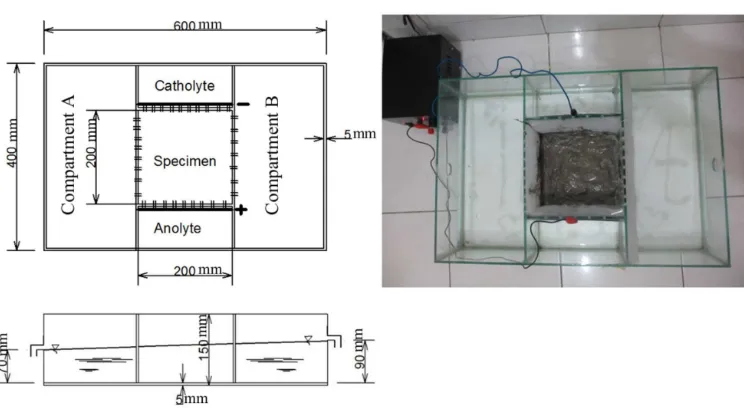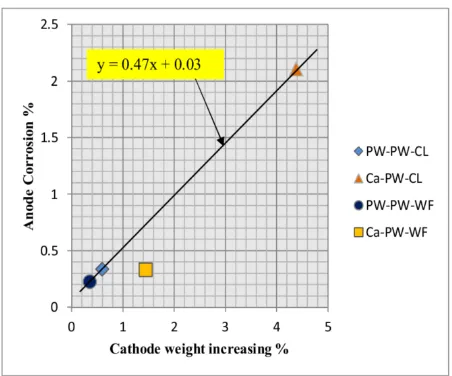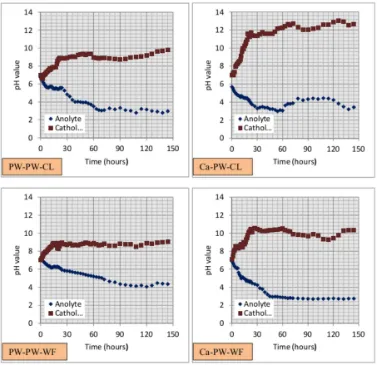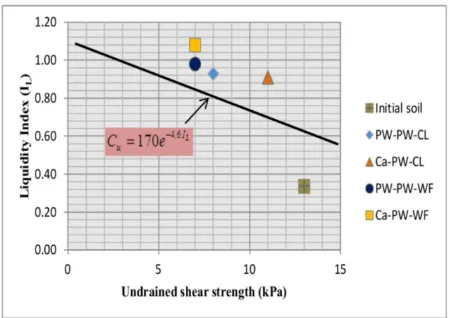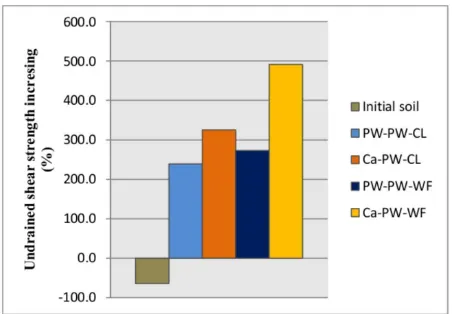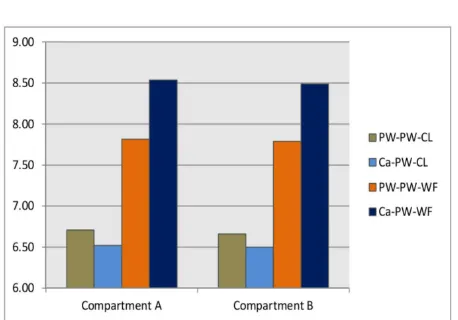IMPROVEMENT OF EXPANSIVE SOIL BY
ELECTRO-KINETIC METHOD
Tran Thi Thanh Thuy∗1, Doni Prakasa Eka Putra1, Wawan Budianta1, and Hemanta Hazarika2
1Geological Engineering Department, Faculty of Engineering, Gadjah Mada University, Yogyakarta, Indonesia 2Geotechnical Engineering Group, Department of Civil and Structural Engineering, Faculty of Engineering, Kyushu
University
Abstract
The roadway in Karangjati, Ngawi Regency, East Java, Indonesia, which is underlain by expansive soil, is susceptible to damage due to volume change. This research aims to improve the engineering prop-erties, such as consistency limits, compressibility, and undrained shear strength of the montmoril-lonite dominated soil in this area using an electro-kinetic stabilization method. Four electro-kinetic experiments were conducted using different elec-trolytes (calcium chloride or pure water) under dif-ferent conditions (no-flow or flow water). The re-sults show that, pH values of all soil samples de-creased at anolyte and inde-creased at catholyte. At-terberg limits of the soil samples were found to in-crease, where the liquid limit (LL) range of 79.72– 86.14%, plastic limit (PL) 25.22–30.80%, and plas-ticity index (PI) 53.28–60.92, liquidity Index (LI) 0.91–1.08. The compression index Cc was 0.50–
0.742. Undrained shear strength of treated soil range of 7–11 kPa. Moreover, strengthening de-gree of the treated soils achieve 304–556%. The soil improvement was achieved by decreasing the Atter-berg limits, and compressibility and increasing the undrained shear strength. Applying calcium chlo-ride and flow water condition were the most effective methods for the soil improvement. The mineralogi-cal compositions of the soil samples did not change after the treatment.
∗Corresponding author: TRAN T. T. T., Department of
Geological Engineering, Faculty of Engineering, Gadjah Mada University, Jl. Grafika 2 Yogyakarta, 55281, Indone-sia. E-mail: [email protected]
Keywords: Electro-kinetic stabilization, electro chemical injection, clayey soil improvement.
1 Introduction
In this paper, the application of electro-kinetic method for improvement of the engineering properties of expansive soil sample obtained from Karangjati, Ngawi Regency, East Java, In-donesia is investigated. Most of the roads in Ngawi have been constructed over expansive soil known as very active clayey soils, which swell when wet and shrink when dry (Por, 2012). Thus, the roadway in Karangjati is sus-ceptible to failure due to pavement cracking and deformation. In order to improve the en-gineering properties of the expansive soil in Karangjati, several electro-kinetic bench scale experiments were conducted.
The electro-kinetic technique is defined as a physical-chemical transport of charge, action of charged particles, and effects of applied elec-tric potentials on formation and fluid transport in porous media (Moayedi et al., 2010). Ionic species in the pore fluid are transported across the soil mass both by electro-migration and by electro-osmotic transport. Electro-kinetic phenomena results from the differential move-ment of two phases, which are solid and fluid phases, with the interface of an electrical dou-ble layer. There are for electro-kinetic phenom-ena: osmosis, migration, electro-phoresis, and streaming potential.
cations will move from the anode toward the cathode by both electro-osmosis and migration. On the other hand, electro-migration phenomena cause anions transport in the revese direction of cations transport, i.e., from the cathode to the anode.
With an application of DC current, the oxida-tion and the reducoxida-tion will occur in turn at the anode and the cathode (Ahmad et.al. 2006).
Anode:
2H2O−4e−→O2 ↑+4H+ Eo= +1.229 (1)
Cathode:
2H2O+2e− →H2 ↑+2OH− Eo=−0.828 (2) where Eo is a standard reduction electro-chemical potential. At the anode, the oxidation process generate an acid front, while at the cath-ode, alkaline will be produced by the reduc-tion process. pH value is different at the elec-trodes, low pH at the anode, and high pH at the cathode. Therefore, the dissolution of ions will occur near the anode and precipitation occurs near the cathode.
Electro-kinetic treatment induces several changes in the pore fluid chemistry, soil fabric, and hydraulic conductivity. The electro-kinetic process can be enhanced by the use of some non-toxic enhancement solutions (stabilization agents), such as lime or calcium chloride solu-tions. These chemical solutions can be fed at either anode or cathode depending on the ions to be transferred into the soil. By the addition of an appropriate enhancement agent, some prop-erties of the soil such as texture, plasticity, com-pressibility and permeability will be altered; therefore they can be very effective in improv-ing soil characteristics by reducimprov-ing the amount of clay size particles and increasing the shear strength (Nasim,et al., 2012). When cations are used as stabilizing agents, ions migrate into soils through processes of electro-migration and electro-osmosis. These ions improve soil strength by three mechanisms, namely cation exchange, mineralization, and precipitation of species in the pore fluid (Thakuret al., 2011). It
is precipitation or mineralization, that provides the greatest contribution to increase in strength. The reaction usually occurs when pH values of the soil solution are greater than seven. There-fore, the pH values of the soil solution need to be maintained above seven during treatment in order to maximize its efficiency by appropriate injection of chemical ions at both electrodes (Jajudin, 2012).
Monovalent cations, such as sodium and potassium, are commonly found in expansive clay soil and these cations can be exchanged with cations of higher valences, such as cal-cium. This ion exchange process takes place quite rapidly, often within a few hours. The calcium cations replace the sodium cations around the clay particles, decreasing the size of the bound water layer and enabling the clay particle to flocculate. The flocculation causes a reduction in plasticity, an increase in shear strength of the clay soil, and an im-provement in texture from a cohesive mate-rial to a more granular, sand-like soil. The change in the structure causes a decrease in the moisture sensitivity and increases the work-ability and constructwork-ability of the soil. The magnitude of soil stabilization is usually mea-sured by the increase in strength as determined from undrained shear strength test (Justin and Robert, 2004).
2 Materials and methods
One natural soil at a site in Karangjati, Ngawi Regency, East Java, Indonesia was taken as soil sample. For electro-kinetic treatment, the sam-ples were prepared near liquid limit condition. The electrolyte solution, which was chosen for treatment, was pure water and calcium chloride with 1 mol/l concentration.
com-partment to prevent the soil particles to move from one side to the other sides while it allows the movement of water and chemical species. The electrode compartments were filled with (a) pure water and (b) chemical solution that is a 1 mol/l solution of calcium chloride con-stituted at anolyte and pure water at catholyte. The selection of the chemical substance and its concentration was chosen based upon the types that have been utilized successfully on a re-search of Ahmad et al. (2011) and Moayedi et al. (2012). The electrolyte solutions need to be observed and maintained (a) no-flow and (b) at flow condition. No-flow condition was created by filling compartment A and B by pure water with 50 mm height. Water was pumped from the compartment A and supply to the com-partment B to create the flow condition. The water-level at the compartment A was 50 mm height and the water lever at compartment B was maintained a 3 mm higher than that at the compartment A causing a small flow of water with hydraulic gradient of 0.005.
Two 1 mm-thick of aluminum plates were used as the cathode and the anode. The se-lection of aluminum electrodes was based on a suggestion of Grey and Schlocker (1969) on their research about electrochemical alteration of clay soils. They noticed two main reasons for choosing Aluminum as electrodes: (1) Alu-minum anodes are often used in engineering practice for electro-osmotic dewatering; (2) Aluminum can be combined with hydroxide ions to form various hydroxyls–aluminum compounds in soil. These compounds have interesting properties: they can interlayer with certain clay minerals or precipitate externally in the pore space as amorphous or crystalline hydroxides and thus modify the mineralogy composition, and presumably the physical properties of soil. Szynkarczuk (1994) also mentioned that Aluminum is the preferred ma-terial since it does not color the supernatant. Tajudin (2012) confirmed the stabilization ef-fects due to strengthening by electro-kinetic can be enhanced by appropriate choice of the electrode material (aluminum instead of steel) or by the addition of sodium silicate or calcium chloride at the anode
The electrodes were connected to a constant electric current DC power supply with output of 10A at 13V. The weight of aluminum elec-trodes was measured before and after electro-kinetic treatment by an electronic balance to de-termine the corrosion effect.
Outline of four electro-kinetic experiments conducted in this research is showed on Table 1. For each test, an approximately 2 kg of nat-ural soil was used. The soil specimen was ap-proximately 5 cm thick. In order to achieve near liquid limit condition, the soil specimen was mixed with pure water and covered by a plastic wrap. During the treatment, the pH values of anolye and catholye were measured at the fol-lowing periods:
• First 12 hours: every 1 hour.
• After 12 hours to 3 days: every 3 hours
• After 3 days: every 6 hours
Each electro-kinetic experiment took approxi-mately 6 days, based on studies conducted by Rustamaji (2007). After the treatment, mois-ture content test, Atterberg limits test, one di-mension consolidation test, un-drained shear strength test, and X-ray diffraction analysis were conducted.
3 Results and discussion
pH value of anolyte and catholyte
Due to electrolysis reactions (i.e., oxidation at the anode and reduction at the cathode), in general, pH value in the anolyte compart-ment tends to decrease while pH value in the catholyte compartment tends to increase. How-ever, the pH value is also affected by water from two-flanked compartment A and B causing the decrease or increase of pH value in the anolyte and catholye compartment is interrupted.
Figure 1: Schematic diagram of the Electro-kinetic bench scale set-up.
Table 1: Electro-kinetic experiments.
Anolyte Catholyte Water condition System
Pure water Pure water Constant level PW-PW-CL
Calcium chloride Pure water Constant level Ca-PW-CL
Pure water Pure water Water flow PW-PW-WF
value of catholyte PW-PW-CL system is greater than PW-PW-WF system. In addition, pH value of Ca-PW-CL system is greater than Ca-PW-WF system. The results indicate that the anolyte would be less alkaline with water flow condi-tion than with no-flow condicondi-tion.
Anode corrosion
Aluminum electrodes used in electro-kinetic treatment became a chemically active material. Under apply a DC power, the cation moves to the anode while the anion moves to the cath-ode. At the anode, the dissolution of aluminum atoms occurs, causing anode to lose its atomic weight. The aluminum ion Al3+ moves from the anode torward the cathode, causing the atomic weight of cathode increasing.
The relationship between corrosion at anode and weight increasing at cathode is showed in Figure 3. In all samples, the increase in the weight of the cathode is greater than the lost of weight of the anode (approximately 2 times). This, confirms that the cathode attracts not only the aluminum anions dissolved from the anode but also calcium ions and the anions exist on soil specimen. Degree of anode corrosion of the Ca-PW-CL system and Ca-PW-WF system is higher than the others indicating that anode corrosion by calcium chloride will be higher than by pure water. On the other hand, de-gree of anode corrosion of Ca-PW-CL system is higher than Ca-PW-WF system and degree of anode corrosion of PW-PW-CL system higher than PW-PW-WF system. This indicates that degree of anode corrosion decreases with flow condition. The high pH value at the catholyte promotes precipitation of calcium and other metals in the cathode. Therefore, the weight of cathode of Ca-PW-CL system increased very high due to its high alkaline environment.
Atterberg limits of treated soil
Table 2 shows the Atterberg limits of the soil before and after electro-kinetic treatments. In general, the liquid limit (wL) and plasticity in-dex (IP) of treated soils became lower than the untreated soil. The decrease in the liquid limit is an indication of the strengthening
be-Figure 3: Distribution corrosion effect at the electrodes after electro-kinetic treatment.
havior of soil specimen. The highest liquid limit and plasticity index (i.e., 86.14 and 60.92, respectively), were shown by Ca-PW-CL sys-tem, which was treated in no flow condition with calcium chloride at the anolyte. Liquid limit and plasticity index of Ca-PW-WF system. which was treated in flow condition with cal-cium chloride at the anolyte, were lowest (i.e., 79.2 and 53.28, respectively).
Compressibility of treated soil
Terzhagi and Peck (1967) after Abbasi (2012) es-tablished a linear correlation between primary compression indexCcand liquid limitLLfor
re-molded soil follows:
Cc= 0.009(LL−10) (3)
Based on Equation (3), the compression index of untreated soil is estimated to be about 0.753. As the result in Table 4 shows that compression indices, Cc of the treated soils were lower than
those of the untreated soils. It is known that the lower theCcis, the stiffer the soil specimen will
be. Thus, treated soil samples were stiffer than the untreated soil samples.
Figure 2: Distribution pH value of anolyte and catholyte after electro-kinetic treatment.
Table 2: Atterberg limit of soil after electro-kinetic treatment.
Atterberg limit Initial PW-PW-CL Ca-PW-CL PW-PW-WF Ca-PW-WF Average Liquid Limit (LL), % 93.68 85.76 86.14 83.55 79.72 83.79 Plastic Limit (PL), % 28.92 30.80 25.22 29.40 26.44 27.97 Plasticity Index (PI) 64.76 54.96 60.92 54.14 53.28 55.83 Natural Water Content
(wN), %
50.64 81.90 80.78 82.28 83.99 82.24
Table 3: Compression index of treated soils.
Po
System Cc (kg/cm2) eo
PW-PW-CL 0.742 0.031 1.787
Ca-PW-CL 0.52 0.03 2.181
PW-PW-WF 0.55 0.03 2.101
Ca-PW-WF 0.50 0.30 2.107
treated with calcium chloride, had lower Cc than PW-PW-CL and PW-PW-WF systems (i.e., Cc equal 0.742 and 0.55, respectively), which treated with only pure water. The resulta in-dicate that soils treated with calcium chloride are stiffer than untreated soils. In the other case, Cc of the PW-PW-WF and Ca-PW-WF sys-tems were lower than PW-PW-CL and Ca-PW-CL systems, respectively. Thus, soil samples treated under the flow water condition were stiffer than those under the no-flow condition were.
Undrained shear strength of treated soil
Undrained shear strength Cu of soil depends on the water content (Rustamaji ,2007). The higher water content, the lower undrained shear strength. Schofield and Wroth (1978; after Rustamaji, 2007) proposed that for remolded soil, the undrained shear strength, Cu, and the liquidity index, LI, are correlated by
Cu=170e−4.6LI (4)
The curve for variation of Cu with LI is
ap-proximately a straight line, which is assumed as a straight line with the undrained shear strength distance about 100 times, from Cu ap-proximately 1.7 (i.e, LI equal 1) to 170 (i.e, LI
equal 0). This straight line performs for almost normally remolded soil (Figure 4). Accord-ing to Rustamaji (2007), when the distribution of treated undrained shear strength fall on the straight line, it means that the treated soil was altered by a change in water content, thus the increase is due to electro-osmotic strengthen-ing. When treated strength distribution falls on the left, below the straight line, it means that no strengthening was achieved. And when treated
Figure 4: Undrained shear strength distribution of untreated and treated soil.
strength falls on the right, above the straight line, it means that strengthening was achieved after treatment. As the results, the distribution of undrained shear strength of soil sample is on Figure 4. Distribution of untreated soil sample is the only one below the straight line. It mean that the untreated soil might be very weak or weaker the normal standard for remolded soil. On the other hand, all treated soils are above the straight line suggesting that the treated soils are stronger than the untreated soil.
For further analysis of strengthening degree of the treated soils, in suggestion of researcher, percentage of strength increasing can be evalu-ated by following equation:
IUSS(%) = Cu
−Cu∗
C∗u (5)
where
IUSS(%): increase of undrained shear strength
Cu(kPa): the undrained shear strength
mea-sured after treatment.
C∗u(kPa): the undrained shear strength
evalu-ated by equation (4)
Figure 5: Distribution of undrained shear strength increasing.
was found in the treated soils using calcium chloride (i.e, PW-CL system, 394%, and Ca-PW-WF system, 556%). On the other hand, the treated soils under water flow condition (i.e, PW-PW-WF system, 338% and Ca-PW-WF, 556%) had degree of increase in strength greater than the treated soils under no-flow condition (i.e, PW-PW-CL system, 304%, and Ca-PW-CL, 394%). These results suggested that electro-kinetic treatment using calcium chloride was effective in strengthening expansive soil more than that using pure water. Besides, small flow of pure water is also an advantage on increas-ing undrained shear strength of treated soil. Flowing water carries the injected ions into the soil pores increasing the possibility of cation ex-change.
Mineralogical composition of treated soil
In order to identify the mineralogical compo-sitions and new crystal of the treated soil, X-ray diffraction (XRD) analyses were conducted. Table 4 summarizes the results of XRD analy-ses of the four treated soil samples. The results of XRD analyses show that no change in min-eralogical composition between untreated and treated soil. The main clay minerals of the soil samples are montmorillonite. It suggest that XRD couldn’t detect any new crystalline struc-ture in the treated soils. This may be due to the low concentration of new crystalline or the res-olution of X-ray diffraction instrument which may be insufficient to detect very small sized
single particles. Although the Scanning elec-tron microscope (SEM) or petrography analysis could detect any new crystalline with a lower 5% concentration, clay particles are too small for optical crystallographic methods to be ap-plied. Therefore, XRD has long been a main-stay in the identification of clay-sized minerals in soils (Harris and White, 2007).
The effect of electro-kinetic treatment on envi-ronment
Water filled in the compartments A and B sim-ulates the influence of ground water when electro-kinetic treatment is applied to the soil in the field. The water of compartment A and B could be change its mechanism due to effect of the electro-kinetic treatment. Surrounding wa-ter before treatment is neutral with pH value approximately 7. After treatment, surrounding water of PW-PW-CL and Ca-PW-CL systems became slightly acidic resulting in the pH value to decrease slightly. On the other case, PW-PW-WF and Ca-PW-PW-PW-WF systems became slightly al-kaline due to increasing pH value.
Distribution of pH value of surrounding wa-ter is shown in Figure 6. The change in pH of the PW-PW-WF Ca-PW-WF system is greater than that of the PW-PW-CL and Ca-PW-CL sys-tem. It confirmed that the treated soils under flow water condition was effective on environ-mental water more than that the treated soils under no-flow condition. On the other hand, the change in pH of the PW-CL and Ca-WF systems is greater than that of the PW-PW-CL and PW-PW-WF systems. This indi-cated that the treated soils using calcium chlo-ride was effective on environmental water more than that the treated soils using pure water.
4 Conclusions
1. Electro-kinetic treatment changed the physical and mechanical properties of the soil samples, as follows:
Table 4: X-Ray Diffraction analysis of untreated and treated soils.
Clay minerals identify Other minerals identify Initial soil Montmorillonite, kaolin Quartz, calcite PW-PW-CL Montmorillonite, kaolin Quartz, calcite Ca-PW-CL Montmorillonite, kaolin Quartz, calcite PW-PW-WF Montmorillonite, kaolin Quartz, calcite Ca-PW-WF Montmorillonite, kaolin Quartz, calcite
Figure 6: Distribution of pH value in compart-ment A and B after treatcompart-ment.
calcium chloride was greater than when treated with pure water. pH value of catholyte of the treated soils under no-flow condition is greater than that under water flow condition.
• In general, LL and PI of all treated soil samples decreased. PL of the soil sample treated with calcium chloride decreased, while that of the soil sam-ples treated with pure water increased slightly.
• All treated soils are stiffer than the untreated soil. Soil samples treated with calcium chloride under water flow condition were the stiffest. The treated soil samples using pure water and under no-flow were less stiff than the others.
2. The undrained shear strengths of the soil samples increased after the treatment. Undrained shear strength of the soil sam-ples treated using calcium chloride under
water flow condition increased signifi-cantly.
3. There is no different in the mineralogi-cal composition of the untreated soil and treated soils observed in the XRD analyses.
References
Abbasi, N., Javadi, A. A., Bahramloo, R. (2012) Pre-diction of compression behavior of normally con-solidated fine-grained soils. World Applied Sci-ence Journal 18 (1), p. 6–14.
Ahmad, K. B., Kassim, K. A., Taha, M. R. (2006) Electroosmotic flows and electromigrations dur-ing electrokinetic processdur-ing of tropical residual soil. Malaysian Journal of Civil Engineering 18(2), p. 74-88,
Ahmad, K. B., Taha, M. R., Kassim, K. A. (2011) Elec-trokinetic treatment on a tropical residual soil. Proceedings of the Institution of Civil Engineers, p. 3–13.
Jajudin, S. A. A. (2012) Electrokinetic stabilization of soft clay. School of Civil engineering, college of Engineering and Physical Science, The University of Birmingham, 295p.
Justin, P. M. and Robert, L. P. (2004) Performance of soil stabilization agents, K-TRAN: KU-01-8, Depatment of Teansportation, The University of Kansas.
Harris, W. and White, N. (2004) Methods of Soil Analysis. Part 5. Mineralogical methods. Soil Sci-ence Society of America Book Series, no. 5, 36p. Szynkarczuk, J., Kan, J., Hassan, T. A. T. and Donini,
J. C. (1994) Electrochemical coagulation of clay suspensions. Clays and Clay Mineral, Vol. 42, no. 6, p. 667–673.
Moayedi, H., Huat, B. B. K., Kazemian, S., Saman, D. (2012) Stabilization of organic soil using sodium silicate system grout. International Journal of Physical Sciences Vol. 7(9), p. 1395–1402.
Nasim, M., Erwin, O., Gary, C. (2012) Review of electrokinetic treatment technique for improving
